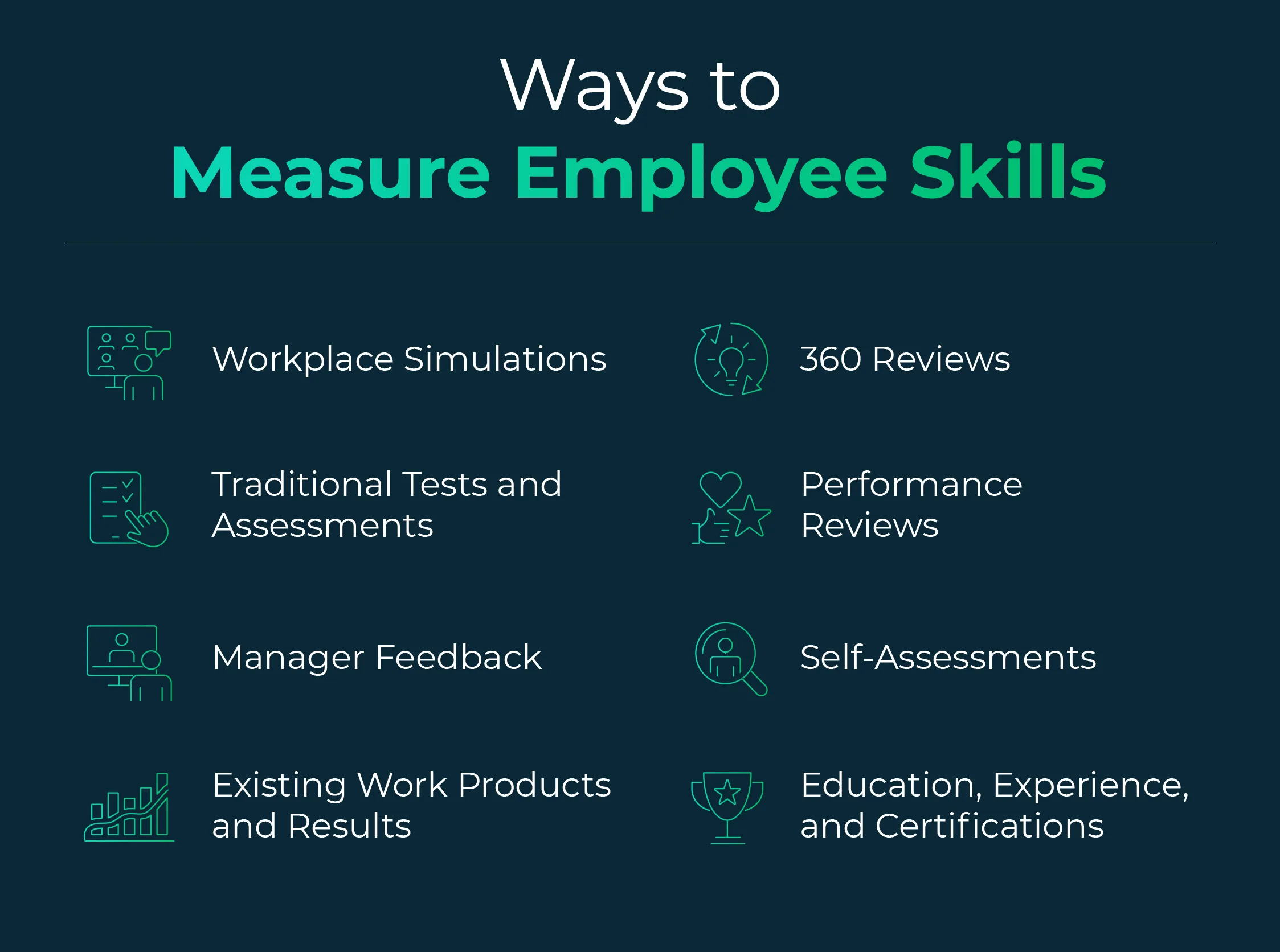How to Assess Employee Skills in the Workplace

An organization is only as strong as its employees. And if those employees lack critical skills, it’s all too easy to fall behind.
But as the business world adapts to a new remote-first reality and rapidly changing technologies, skills gaps have widened. And many organizations lack clear insight into what skills their teams lack and even what they need.
To address internal weaknesses and adapt to changing conditions, organizations can first measure and assess employee skills.
Employee Skills Assessment: The Basics
Employee skills assessment is the process by which organizations measure employees’ capabilities and readiness to excel at their jobs. While specific job skills assessments come in various forms and range from simple to complex, you’ll ideally conduct such assessments within the context of a broader organizational strategy. They can both assess a job candidate’s suitability for a role and identify the strengths and weaknesses of existing employees.
When done at scale, these employee skills assessments allow organizations to conduct an inventory of the skills represented among their employees, identify gaps, and use that information to provide targeted training and growth opportunities.
Why Should Organizations Measure or Assess Employee Skills?
To succeed in a competitive marketplace, companies need to ensure strong alignment between skills and business goals. Without the necessary skills, goals are unreachable; but without clear goals, identifying the necessary skills and acquiring the right talent becomes impossible. An effective skill inventory, therefore, should be conducted alongside a review of organizational goals to help the company understand the health of the organization related to specific skills and competencies.
Traditionally, many organizations have relied on candidates’ and employees’ educational and employment backgrounds to understand their skill sets, according to the American Institute for Research. The pace of change today, though, means many employees work in roles that may not have existed when they were in school or that have changed significantly.
That may mean they have extensive skills that traditional measures haven’t captured. Or, it may mean that while their credentials align with their jobs, the training they received was not up to date. Thus, alternative approaches that allow employers to assess employee skills regularly to maintain a current understanding of their organizational capabilities have become invaluable.
According to the Harvard Business Review, moving toward a skills-based approach to assessing candidates and employees can also help employers identify untapped sources of talent within their workforce and create fairer hiring processes.
How Do Job Skills Assessments Benefit Individual Employees?
Individual employees can also benefit significantly from skills assessment programs. Employees who base their understanding of their skill sets on their formal training may have an incomplete picture. They may not realize just how many skills they’ve picked up on the job or lack clarity on the knowledge they need to grow into new roles.
To maximize their employability, employees need to understand their baseline skill set and how they can transfer those skills into different types of roles, as well as the skills they are likely to need to acquire in the future.
When organizations pair skills assessments with training and development, employees are even better positioned to grow their careers.
What Are the Best Approaches for Measuring Skills?
While there are numerous ways to measure skills and create an organizational inventory, they are generally most effective when used together to gain a complete picture of an organization’s talent base—especially since the most effective form of assessment often varies relative to the skill itself. Combining the results from a range of assessments is likely to lead to the most comprehensive and reliable data set.
1. Start with the information you have.
Companies’ existing data on their employees is a great starting point for creating skills profiles. Performance reviews and feedback from managers related to outcomes in specific areas can provide invaluable insight. In addition, organizations can scrape employees’ LinkedIn profiles and resumes to identify those who have particular skills that may not be tapped in their current roles (such as certain software tools or programming languages).
2. Ask your employees about their expertise.
While self-assessments, by nature, provide imperfect information, they offer a good baseline for identifying the areas in which employees have some background. Consider providing questionnaires that can be used in conjunction with more objective assessments, and remember that while some employees may exaggerate their abilities, others may underestimate them.
3. Evaluate their work products.
You can partially evaluate many skills, ranging from writing to management, by measuring the quality of employees’ existing work. While this can be trickier to do at scale, organizations can consider building more skill-specific work assessments into performance reviews. Additionally, leaders can ask managers to provide regular feedback on the quality of specific types of work for relevant employee groups.
4. Conduct hard skills tests.
Some skills, especially technical or “hard skills,” are fairly easy to measure through objective assessments. This may look like asking an employee (or candidate) to demonstrate how to use a specific piece of equipment or write a page of code. A number of companies offer formal skill assessment programs (often online), or companies can create their own.
5. Assess soft skills.
While “soft skills” like communication and leadership may appear more challenging to measure, their importance cannot be underestimated. Simulations in which employees are asked how they would respond in various situations can measure skills like flexibility and emotional intelligence. In the context of interviewing, hiring managers can ask candidates for examples of cases in which they have demonstrated specific soft skills.
6. Offer 360 reviews.
In so-called 360 reviews, employees are assessed not only by their managers but also their peers and direct reports (if any). These are particularly useful at identifying strengths and weaknesses related to specific skills. In many cases, those colleagues are better positioned to assess the employee’s day-to-day work than their manager.
Best Practices for Implementing Employee Skills Assessments
As organizations make plans to assess employee skills in the workplace, they must take several key considerations into account.
1. Ensure the employee skills assessment is tied to business objectives and goals.
Unless organizations know what they are looking for, the results of skills assessments won’t be of much use. Leaders should map skills assessment efforts against business objectives. They should pair this with a clear understanding of what skills they need for the business to reach its goals.
2. Clearly communicate the purpose of the assessments to employees.
Skills assessments can be a source of stress for employees who believe their employer may use them to “weed out” staff. Therefore, make it clear that the assessment process is instead meant to help the company and employees reach their full potential.
3. Don’t get too granular or too high-level.
It’s easy for skills assessments to burgeon in size with too much detail. Alternately, assessments that remain too high-level are unlikely to provide actionable information. Instead, assessments should be designed to identify broad groups of skills likely to align with learning and career paths.
4. Make a plan to use the data.
Data is only valuable when it’s used to inform action. Before embarking on employee skills assessment programs, organizations should make a plan to address any gaps that they uncover. Often, gaps can be addressed through reskilling and upskilling. This is especially true when employers design assessments to identify transferable skills and areas of talent.
Employee skills assessment programs, when approached strategically, are a win-win for both organizations and employees. They provide both the data that employers need to identify areas of weakness and insights into a path forward.
As organizations prepare for the jobs of the future, mapping out existing skill sets will prove invaluable.
Are you designing an employee skills assessment program to address gaps through targeted employee training? Learn more about working with Emeritus Enterprise to design online employee training programs that fit your needs.




